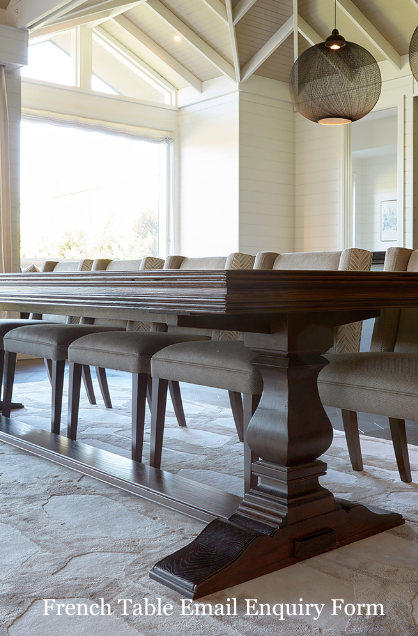Why a French Refectory Table Is Ideal for Large Gatherings and Big Families
A French refectory table is a long, sturdy timber table originally used in 17th-century French monasteries. Built for communal meals, these French tables are defined by their generous size, solid structure, and pared-back elegance.
So why do they work so well in family homes today? The answer is simple: they’re practical, beautiful, and spacious. If you’ve ever tried hosting a large gathering around a cramped dining setup, you’ll understand the appeal. A large dining table that welcomes everyone—without folding chairs or crowded elbows—makes all the difference.
Historical Roots of Communal Dining
Refectory tables first appeared in French monastic settings. At first, these French tables were not ornamental—they were functional, made to withstand heavy use. The design hasn’t strayed far from that original intent. This history of togetherness is part of what makes a French refectory table so suitable for big families today. It’s built for sharing: space, food, and conversation.
Size and Seating Capacity
French refectory tables are typically longer and narrower than standard dining tables. With ample legroom to prevent that embarrassing knee-clash under the table, many can easily fit 8 to 12 people.
Seating is flexible, too. Some prefer a bench on one side and chairs on the other. Others mix timber and upholstered seating for contrast. The long frame opens up a lot of options, depending on the look and layout you want.
Functionality Beyond Dining
A large dining table isn’t just for dinner. It becomes the base for everything from schoolwork to family board game nights. During the holidays, it can double as a buffet station or crafting zone. On ordinary days, it’s where homework is done, laptops are opened, or puzzles come out.
That’s why many families choose a French table that does more than just hold plates. A French refectory table fits easily into this kind of flexible, lived-in rhythm.
Aesthetic Appeal and Timeless Design
Though their roots are in simplicity, French refectory tables give a place a subdued beauty. The lines are neat, the timber is substantial, and generally there is a grounded presence. They’re not flashy, but they also don’t vanish into the backdrop either.
This makes matching them with a range of interiors simple. A French refectory table fits nicely in your house, whether it leans rustic, coastal, modern, or something else entirely. Its scale gently grounds a room without overwhelming it.
Durability for Everyday Use
Materials like oak and walnut are often used in traditional refectory table designs. These woods are dense, hardwearing, and able to handle the wear that comes with daily life. If you’re looking for something that can keep up with spilled juice, scattered homework, or occasional dropped cutlery, this kind of French table is up for the task.
And rather than worrying about every scratch, you’ll find that signs of use actually enhance its surface. Like many Australian made dining tables, they age with grace, gaining warmth and depth over time.
Emotional and Social Value
The French refectory table isn’t just practical—it’s also personal. Meals shared at a large dining table tend to linger a little longer. People settle in. Conversations unfold.
Over time, it becomes more than a surface. It carries the marks of everyday life: dents from dropped forks, candle wax from birthdays, faint ink smudges from schoolwork. For families who gather often, those traces aren’t imperfections. They add character and lasting memories.
Conclusion
A French refectory table brings together size, strength, and softness. It’s a location to eat, hang out, work, and chat. The French refectory table fits naturally into homes that value space, connection, and enduring quality with its spacious dimensions, classic design, and aesthetic appeal.
It’s a large dining table with a quiet presence—and for many families, that’s exactly what makes it right.If you’re considering an Australian made dining table that brings function and character to your space, luxury interior designer and furniture manufacturer Mark Alexander offers a range of French refectory tables worth exploring.



